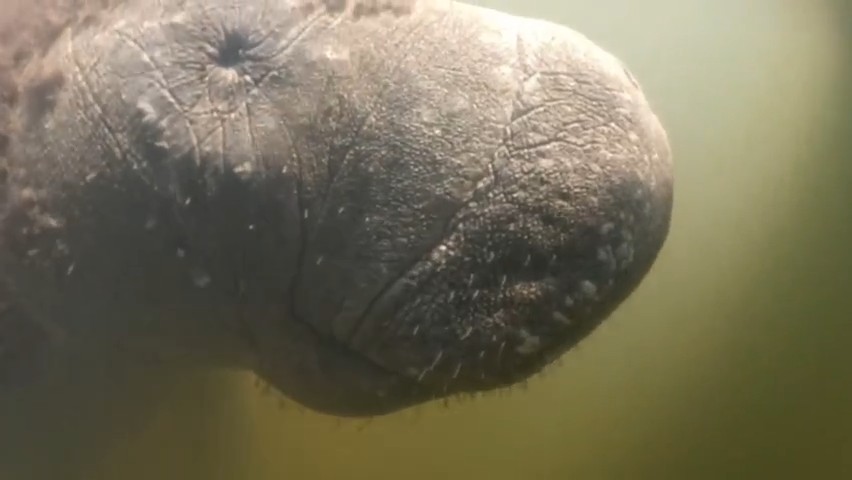Manatees, often described as gentle giants of the sea, gracefully navigate Florida’s waterways. These large, peaceful herbivores, also known as sea cows, can be an amazing sight while swimming, boating, or simply enjoying the waterfront. Encountering a manatee might spark a natural curiosity and desire to interact, perhaps even touch these seemingly docile creatures. However, despite their approachable appearance, it’s crucial to understand why touching a manatee is not only discouraged but also illegal. This article will explore the reasons behind the “look, but don’t touch” rule, ensuring both your safety and the well-being of these protected marine mammals.
Manatees are native to Florida and belong to a subspecies of the West Indian manatee. They thrive in the warm waters, spending their time swimming, feeding on seagrass, and resting. These impressive animals can grow to be between 10 and 13 feet long and weigh anywhere from 1,200 to 3,000 pounds. While they might appear playful with their barrel rolls and somersaults, human interaction can pose significant risks to their health and survival. The Florida Fish and Wildlife Conservation Commission (FWC) provides clear guidelines on how to behave when near manatees, and these guidelines are in place for good reason.
The Legal Protections for Manatees: Why Touching is Against the Law
You might wonder, “Can you legally touch a manatee?” or “Will I be arrested for touching a manatee?” While a manatee accidentally brushing against you won’t lead to legal trouble, actively attempting to touch, pet, or interact with a manatee is a violation of both state and federal laws.
Manatees are protected under the Marine Mammal Protection Act of 1973 and the Florida Manatee Sanctuary Act of 1978. These acts make it illegal to harass, harm, pursue, hunt, wound, kill, annoy, or molest manatees. “Molest” in this context includes touching or any unwanted physical interaction. The story of Ryan William Waterman serves as a stark reminder. In 2013, he was arrested for posting pictures of himself and his children petting a manatee calf, even lifting it out of the water. He faced potential fines and jail time, highlighting the seriousness of these laws.
Specifically, prohibited activities include:
- Feeding or giving water to manatees, or using these to attract them.
- Separating a mother manatee from her calf.
- Disturbing mating herds or resting manatees.
- Chasing or pursuing manatees in the water or with a vessel.
- Any physical contact, including hitting, jumping on, holding on to, or attempting to ride a manatee.
- Blocking a manatee’s path.
- Fishing for or attempting to hook or catch a manatee.
Touching a manatee can result in penalties under the Manatee Sanctuary Act, with fines reaching up to $500 and a jail term of up to 60 days. Furthermore, actions deemed as abuse or harassment leading to injury or death can trigger federal protection laws, escalating penalties to a $50,000 fine and/or imprisonment for up to one year.
Why Physical Contact Harms Manatees: Understanding the Impact
Beyond the legal ramifications, understanding why you can’t touch a manatee is crucial for responsible wildlife interaction. Manatees are remarkably sensitive creatures, and human interaction can cause them significant stress, especially to vulnerable young calves. This stress can have serious consequences for their well-being.
Threatened manatees might abandon warm water habitats that are vital for their survival, particularly during colder months. This displacement can lead to cold-stress syndrome, a potentially fatal condition for manatees. Moreover, when manatees become accustomed to human interaction, they may lose their natural fear of humans and boats. This habituation drastically increases their risk of injury or death from boat strikes, which are already a leading cause of manatee fatalities in Florida.
What to Do If a Manatee Approaches You: Respecting Their Space
Encountering a manatee up close can be an exciting experience, but it’s essential to react responsibly. If a manatee approaches you, it generally indicates that you are in its space. While it’s unlikely a manatee will intentionally harm you, the appropriate response is to move away calmly and carefully. The key principle is “look, but don’t touch.”
Avoid chasing the manatee or attempting to get closer for a better view or photo opportunity. Do not single out individuals from a group or, crucially, separate a mother from her calf. Never poke, prod, or stab a manatee with your hands, feet, or any object. Resist the urge to grab, pinch, hit, or attempt to ride a manatee.
When manatees are nearby, minimize noise and splashing. Manatees can hold their breath for up to 20 minutes and might surface unexpectedly, unaware of your presence. Sudden loud noises or splashing can frighten them. If you observe a tag or research equipment on a manatee, it’s especially important to leave it undisturbed.
Guidelines for Responsible Coexistence: Protecting Manatees in Their Habitat
To ensure the safety and conservation of manatees, it’s vital to adhere to specific guidelines in various situations:
- Boating: Watercraft collisions are a major threat to manatees. Always obey posted speed zone restrictions, especially in manatee habitats. Report any accidental collisions immediately to increase the manatee’s chances of survival. Look out for “manatee footprints”—circular wave patterns on the water’s surface indicating a manatee below. Wear polarized sunglasses to reduce glare and improve visibility. Be mindful that manatees often move to channels when they hear approaching boats in shallow areas. Properly dispose of plastics, fishing lines, and ropes to prevent entanglement.
-
Paddleboarding: Exercise caution near seagrass beds and manatee sanctuaries. Avoid paddling directly over submerged manatees as they need to surface to breathe and might be startled, potentially knocking you into the water.
-
Swimming and Viewing: While you can’t swim with manatees in an interactive sense, you can swim and observe them responsibly. Designated manatee viewing areas, like those in Crystal River National Wildlife Refuge and Blue Spring State Park, offer safe observation points. Always respect “NO ENTRY MANATEE REFUGE” zones, as these are critical habitats. Consider using snorkel gear instead of SCUBA gear, as the bubbles from SCUBA can disturb manatees.
-
Reporting Injured or Distressed Manatees: If you encounter a sick, injured, or dead manatee, report it immediately to the Florida Fish & Wildlife Conservation Commission wildlife emergency hotline at 1-888-404-3922. Be prepared to provide details about the manatee’s condition, location, size, and any tags. Photos and videos can also be helpful for biologists. Never attempt to rescue a distressed manatee yourself; trained professionals are equipped to handle these situations safely.
Conclusion: Observing with Respect and Ensuring Manatee Conservation
The rule of “look, but don’t touch” when it comes to manatees is not just a suggestion; it’s a legal requirement and a crucial aspect of manatee conservation. By understanding the reasons behind this rule—protecting manatees from stress, habituation, and physical harm—we can all contribute to their well-being. Enjoy the privilege of observing these magnificent creatures in their natural habitat, but always remember to maintain a respectful distance and never attempt to touch or interact with them physically. Your responsible actions play a vital role in ensuring that manatees continue to thrive in Florida’s waters for generations to come.

